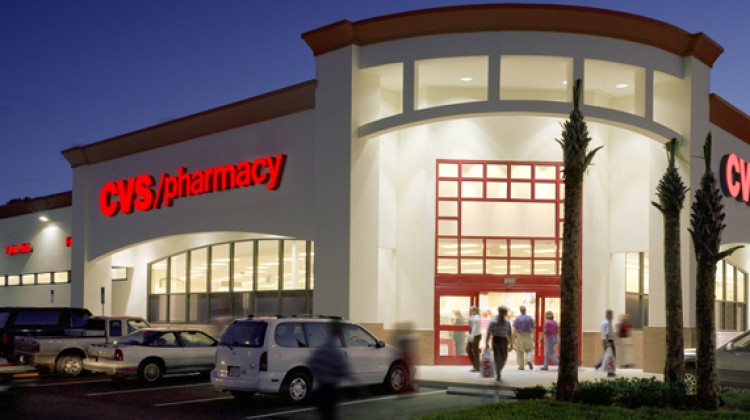Sales climb despite declined results in retail pharmacy unit

WOONSOCKET, R.I. — Despite declines in its retail pharmacy business, CVS Health saw sales rise and beat Wall Street’s earnings projections for its fiscal 2017 first quarter.
CVS said Tuesday that for the quarter ended March 31, revenue totaled $44.51 billion, up 3% from $43.22 billion a year earlier.
Sales in the company’s Retail/LTC Segment, which includes the CVS Pharmacy and Omnicare businesses, fell 3.8% in the first quarter to $19.34 billion from $20.11 billion in the prior-year period. CVS said the decrease stems mainly from a 4.7% decline in same-store sales, reimbursement pressure and a higher generic drug dispensing rate, which had a deflationary effect on sales.
Front-end same-store sales were down 4.9%, reflecting negative impacts of 100 basis points from the absence of leap day versus last year and 75 basis points from the shift of the Easter holiday to the second quarter in 2017. CVS also said softer customer traffic and efforts to rationalize promotional strategies, partially offset by growth in basket size, impacted front-end results.
Comparable pharmacy sales in the quarter decreased 4.7%, including a negatively impact of 480 basis points from introductions of new generics. Prescription count dipped 1.4% on a 30-day equivalent basis.
CVS reported that pharmacy network changes negatively impacted comparable-pharmacy prescriptions filled by 460 basis points, and the absence of leap day versus a year ago had a 120-basis-point negative impact script count. The company said same-store prescription volumes, adjusted for the network changes and leap day, would have been 580 basis points higher and risen 4.4% in the quarter on a 30-day equivalent basis.
In the Pharmacy Services Segment, which includes the pharmacy benefits management business, revenue climbed 8.5% in the 2017 first quarter to $31.22 billion from $28.77 billion a year earlier. CVS attributed the gain primarily to 10.5% growth in pharmacy network claim volume (on a 30-day equivalent basis), brand inflation and growth in specialty pharmacy, partially offset by higher generics dispensing and price compression.
The rise in pharmacy network claim volume came mostly from an increase in net new business, CVS said. Mail choice claims processed rose 4.5% on a 30-day equivalent basis, fueled mainly by adoption of the Maintenance Choice program and an uptick in specialty pharmacy claims, according to the company.
For the first quarter, the generic dispensing rate rose 180 basis points to 87.5% in the Retail/LTC Segment and was up 140 basis points to 87% in the Pharmacy Services Segment, CVS said.
“2017 is off to a solid start, as we posted results this quarter that surpassed our expectations. At the same time, we generated $3.1 billion of free cash and continued to return value to our shareholders through high-return investments in our business as well as dividends and share repurchases,” CVS Health president and chief executive officer Larry Merlo said in a statement. “However, while we are pleased with our financial performance versus our expectations, we won’t be satisfied until the company returns to sustainable, healthy earnings growth.”
Operating profit fell 18% to $1.79 billion in the first quarter, reflecting the impact of the pharmacy network changes, price compression in the Pharmacy Services Segment and reimbursement pressure in the Retail/LTC Segment, according to CVS. The company said the decrease also include a $199 million charge from the closing of 60 retail stores in an enterprise streamlining initiative, partially offset by a $46 million decrease in acquisition-related integration costs versus the year-ago period.
First-quarter net earnings came in at $953 million, or 92 cents per diluted share on a GAAP basis, compared with nearly $1.15 billion, or $1.04 per diluted share, a year ago. CVS attribued the decline primarily to the decrease in operating profit, partially offset by lower interest expense and an improvement in the effective income tax rate. Adjusted earnings per share were $1.17 in the 2017 quarter and $1.18 in the year-ago period.
Analysts, on average, had forecast adjusted EPS of $1.10 for CVS’ first quarter, with estimates ranging from a low of $1.09 to a high of $1.13, according to Thomson Reuters.
CVS reaffirmed its fiscal 2017 guidance, projecting GAAP diluted EPS of $5.02 to $5.18 and adjusted EPS of $5.77 to $5.93 for the full year. Analysts’ consensus estimate is for adjusted EPS of $5.86, with projections running from a low of $5.80 to a high of $5.95, according to Thomson Reuters.
For the second quarter, CVS expects GAAP diluted EPS of $1.15 to $1.19 and adjusted EPS of $1.29 to $1.33. Analysts average estimate is for adjusted EPS of $1.33, with the forecast ranging from $1.28 to $1.40.
“We continue to expect 2017 to be a rebuilding year. But our goals remain clear, and we fully intend to return to healthy levels of growth,” Merlo added. “We remain confident in our model as well as our position in the evolving health care landscape, and our ability to generate significant levels of cash will continue to play an important role in driving shareholder value over the longer term.”
CVS plans to close 70 retail stores during 2017 and take a charge of about $220 million, mainly from the lease obligations of those stores. The company said it closed 60 of the 70 retail stores in the first quarter and took a charge of $199 million. The other 10 stores are slated to be closed during the rest of the year.
In the first quarter, CVS opened 27 new retail stores and relocated 10 retail stores. As of March 31, the company operated 9,676 retail stores (including pharmacies in Target stores) in 49 states, the District of Columbia, Puerto Rico and Brazil.




You must be logged in to post a comment Login